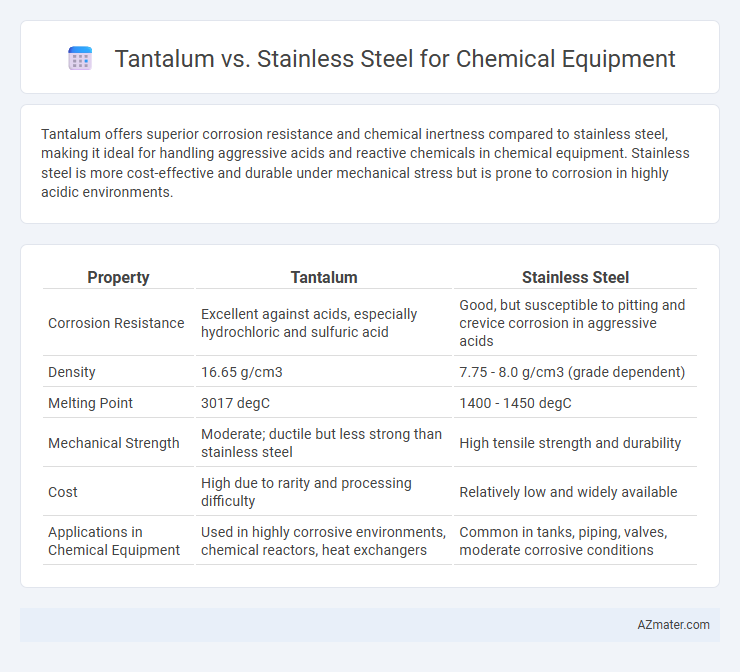Tantalum offers superior corrosion resistance and chemical inertness compared to stainless steel, making it ideal for handling aggressive acids and reactive chemicals in chemical equipment. Stainless steel is more cost-effective and durable under mechanical stress but is prone to corrosion in highly acidic environments.
Table of Comparison
| Property | Tantalum | Stainless Steel |
|---|---|---|
| Corrosion Resistance | Excellent against acids, especially hydrochloric and sulfuric acid | Good, but susceptible to pitting and crevice corrosion in aggressive acids |
| Density | 16.65 g/cm3 | 7.75 - 8.0 g/cm3 (grade dependent) |
| Melting Point | 3017 degC | 1400 - 1450 degC |
| Mechanical Strength | Moderate; ductile but less strong than stainless steel | High tensile strength and durability |
| Cost | High due to rarity and processing difficulty | Relatively low and widely available |
| Applications in Chemical Equipment | Used in highly corrosive environments, chemical reactors, heat exchangers | Common in tanks, piping, valves, moderate corrosive conditions |
Introduction to Tantalum and Stainless Steel
Tantalum is a corrosion-resistant metal known for its exceptional ability to withstand aggressive chemical environments, making it ideal for chemical equipment exposed to highly acidic or reactive substances. Stainless steel, an alloy comprising primarily iron, chromium, and nickel, offers excellent durability and general corrosion resistance, particularly suitable for less corrosive applications. The choice between tantalum and stainless steel depends on factors such as chemical compatibility, temperature tolerance, and cost efficiency in specific industrial processes.
Chemical Resistance Comparison
Tantalum exhibits exceptional chemical resistance, particularly against strong acids like hydrochloric acid and sulfuric acid, making it ideal for highly corrosive environments in chemical equipment. Stainless steel, though durable and resistant to many chemicals, is susceptible to pitting and stress corrosion cracking in aggressive acid media. The superior inertness of tantalum ensures longer equipment lifespan and reduced maintenance in harsh chemical processing applications.
Mechanical Properties and Strength
Tantalum exhibits superior corrosion resistance and maintains high tensile strength up to 480 MPa at room temperature, making it ideal for highly corrosive chemical environments where mechanical durability is critical. Stainless steel, particularly grades like 316L, offers tensile strength around 485 MPa and excellent mechanical robustness but is more prone to corrosion in aggressive media compared to tantalum. The high melting point of tantalum (3017degC) also contributes to its mechanical stability under extreme temperatures, whereas stainless steel's melting point lies around 1400-1450degC, limiting its performance in high-temperature chemical applications.
Corrosion Resistance in Aggressive Environments
Tantalum exhibits superior corrosion resistance in aggressive environments due to its exceptional inertness against strong acids such as hydrochloric and sulfuric acid, outperforming stainless steel in highly corrosive chemical processes. Stainless steel, while durable and cost-effective, is prone to pitting and crevice corrosion when exposed to chloride-rich or highly acidic conditions, limiting its application in harsh chemical settings. Choosing tantalum ensures longevity and reduced maintenance in chemical equipment handling aggressive substances, making it ideal for applications requiring exceptional resistance to chemical attack.
Temperature Tolerance and Thermal Stability
Tantalum exhibits superior temperature tolerance and thermal stability compared to stainless steel, withstanding temperatures up to 3000degF (1649degC) without significant degradation. Stainless steel typically endures temperatures up to 1600degF (870degC), beyond which corrosion resistance and mechanical strength decline. This makes tantalum the preferred choice for chemical equipment in high-temperature, corrosive environments requiring prolonged thermal exposure.
Cost Analysis of Tantalum vs Stainless Steel
Tantalum offers exceptional corrosion resistance in aggressive chemical environments but comes at a significantly higher initial cost compared to stainless steel, often costing up to 20 times more per kilogram. Stainless steel provides a more cost-effective solution with moderate corrosion resistance suitable for many chemical processes, reducing upfront capital expenditure and easing maintenance costs. Total cost analysis must factor in the lifespan and chemical compatibility, where tantalum's durability can offset its initial expense in highly corrosive applications, while stainless steel remains preferred for less aggressive environments due to its economic advantage.
Longevity and Maintenance Needs
Tantalum offers exceptional corrosion resistance against aggressive chemicals, significantly enhancing longevity in chemical equipment applications compared to stainless steel. Stainless steel requires more frequent maintenance due to its susceptibility to pitting and crevice corrosion in harsh chemical environments. The superior durability and minimal upkeep of tantalum result in lower overall lifecycle costs despite its higher initial investment.
Fabrication and Machinability
Tantalum offers superior corrosion resistance and biocompatibility in chemical equipment fabrication, though it poses challenges due to its high density and work hardening tendencies, requiring specialized welding and forming techniques. Stainless steel, particularly grades like 316L, provides excellent machinability and cost-effective fabrication with widely available tooling and established processes, but it may lack the chemical resistance needed for highly aggressive environments. Selecting between tantalum and stainless steel depends on balancing fabrication complexity and machining efficiency against corrosion resistance demands in the intended chemical applications.
Applications in Chemical Processing Industries
Tantalum exhibits exceptional corrosion resistance to aggressive chemicals such as hydrochloric acid and sulfuric acid, making it ideal for highly corrosive environments in chemical processing industries. Stainless steel, particularly grades 316 and 304, is widely used for chemical equipment due to its strength, cost-effectiveness, and good resistance to a broad range of chemicals including alkalis and organic substances. Tantalum is preferred in applications involving high-temperature acid handling and strong oxidizers, while stainless steel dominates in less severe conditions and general-purpose chemical reactors, tanks, and piping systems.
Choosing the Right Material: Key Considerations
Tantalum offers superior corrosion resistance against aggressive chemicals like hydrochloric acid and strong oxidizers, making it ideal for highly corrosive chemical equipment environments. Stainless steel, notably grades 316L and 904L, provides excellent mechanical strength and cost-effectiveness but can be susceptible to pitting and crevice corrosion in chloride-rich or highly acidic conditions. Selecting between tantalum and stainless steel depends on factors such as chemical compatibility, temperature tolerance, budget constraints, and maintenance requirements to ensure durability and safety in chemical processing applications.

Infographic: Tantalum vs Stainless Steel for Chemical Equipment
 azmater.com
azmater.com